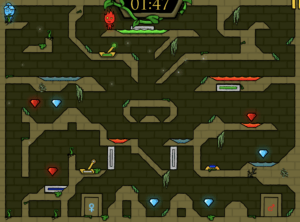For this week’s critical play, I played Oslo Albet’s Fireboy and Watergirl on my computer.
One of this game’s key mechanics is the user’s ability to control both Fireboy and Watergirl separately using different keys on the keyboard, using the arrow keys for Fireboy and WASD for Watergirl. This mechanic causes the user to carefully consider which character should be moved when in order to solve the puzzle. Solving a puzzle with one character can be difficult enough, but solving with two, that are both under your control, is a whole new experience. This mechanic is a new way to highlight the fellowship type of fun. In this game, the fellowship is between your left hand and your right hand. Another interesting mechanic of each level that influences the experience of the game comes from how users interact with inanimate objects of the game, such as switches and stone blocks. These objects are not merely obstacles; the user must strategically interact with these objects and move them around in order to solve certain puzzles.
This mechanic of object interaction and movement leads to an interesting dynamic when combined with the mechanic of collecting the diamonds spread over the map. There are red diamonds that can only be collected by Fireboy, and blue by Watergirl. While playing this game, there were occasions where I moved an object to a certain position, perhaps over a ledge, and this movement prevented me from collecting a diamond. For example, on one level I needed to stand on a box in order to be able to jump and reach a diamond, but I accidentally pushed the box off a ledge. However, the game did not immediately stop when this occurred, so I manually had to restart the level in order to return the box to its original position. These interactions ramp up the challenge type of fun, providing barriers to reaching the end of the level that are not merely obstacle avoidance.
Despite these mechanics and the nontrivial dynamics that they produce, the game’s controls remain incredibly simple. There are only a small handful of controls available to users, and I have seen this game provide a submission type of fun in the past, as I’ve watched my high school classmates mindlessly play it in class. Although I have seen it used as a pastime, taking a closer look at the mechanics at play changed how I viewed this classic game.



